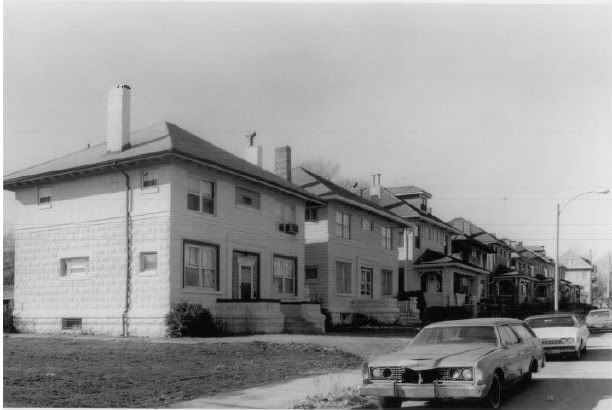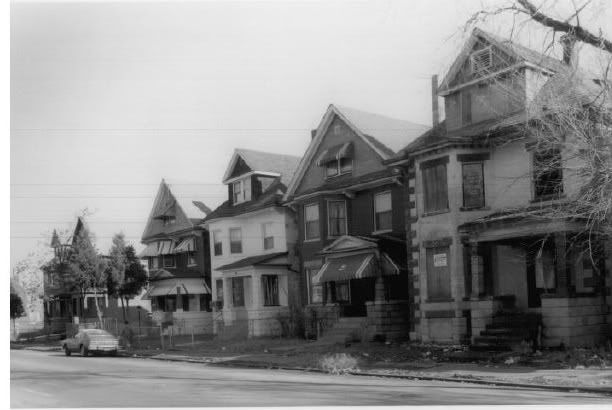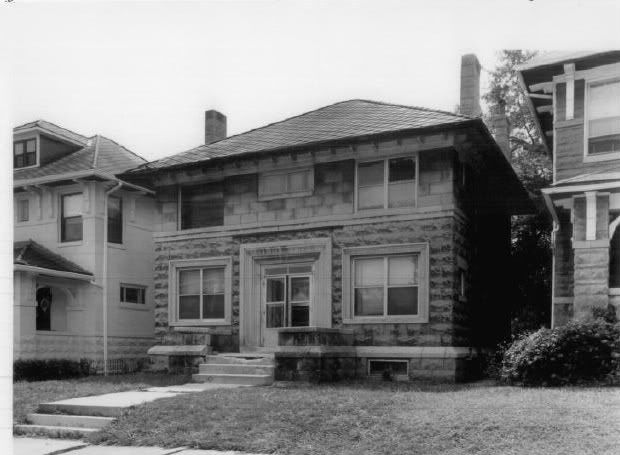Search This Blog (A.K.A. "I Dote On...")
Monday, June 14, 2010
June Preservation Board Agenda Online 10:37 PM
On the agenda are:
-A preliminary review of lighting at Aloe Plaza
-A preliminary review to extend an existing roof deck in Lafayette Square.
-A preliminary review to renovate 6120 Delmar (blogged here) in the East Loop, while demolishing a non-contributing addition.
-Review of proposal to install an illuminated ground sign with reader board at St. Francis DeSales Catholic Church.
-An appeal of staff denial of an application to replace third floor front window in the Central West End.
-An appeal of staff denial to retain 7 vinyl windows installed without a permit in Fox Park.
-An appeal of staff denial to retain exterior wrapping on front windows installed without a permit, also in Fox Park.
-An appeal of staff denial to retain a front door installed without a permit, in Benton Park.
-A new application to install solar panels on front roof slope, also in Benton Park.
Proposed demolitions are below:
-6044 Cates, in the West End neighborhood (photo from Geo St. Louis)
4308 Gano, in the Fairground Neighborhood. (Photo from Bing Maps).
4623 Kennerly, in the Greater Ville neighborhood. (Photo from Bing Maps).
The Preservation Board meeting is held at 1015 Locust, Suite 1200.
The date is June 28th at 4 p.m.
Wednesday, February 10, 2010
The "Other" West End 9:51 PM
Today's West End neighborhood is considered a solid part of the North Side, being located north of Delmar. Most people don't consider that this neighborhood shares the East Loop with Skinker-DeBaliviere; contains one of the oldest houses in the city; was indeed once part of that nebulous and larger West End region that was defined by its wealth and prestige.
If you read the History of Urban Renewal in St. Louis, you'll discover that the West End (current definition) was one of the city's countless "urban renewal" areas. Usually this meant mass demolition for new construction and green space. However, the West End was a late urban renewal zone. By the dawn of the 1970s, Pruitt-Igoe and like-public housing projects were rapidly losing favor. The federal government's Model Cities program contained public participation requirements for urban redevelopments receiving federal funding; through this more democratic approach, mid-century planners were beginning to hear the voices of unrest and upheaval. To their surprise, many low-income residents liked their neighborhoods and did not want to see them cleared outright.
Accordingly, in the West End, the intent was rehabilitation of the bulk of the neighborhood's fine homes. The plans also called for a popular crime-deterring technique of the 1970s, one that has scarred the city throughout--street closures and other disruptions to the grid. Sadly, planned rehabilitations in the West End Urban Renewal Area were outpaced by demolitions. The street grid was still marred as planned, in many cases.
Today's West End has little relation to the better known Central West End, socioeconomically or otherwise. There are some new homes:
These homes are located on the 5800 block of Clemens. Their presence is probably a good sign for the neighborhood, though their execution could clearly have been better. Driveways should be banned in most of St. Louis's urban neighborhoods, including the West End. In addition, the city should probably discourage the brick facade-vinyl siding phenomenon in a well-articulated urban design guidelines. Still, the several blocks that have witnessed these new homes are at least no longer desolate.
Even better, the West End contains one of the city's most picturesque and historic private streets--West Cabanne Place. It has sustained some high profile losses, but for the most part is intact. For a great history of the Cabanne area, please make sure to see the immaculate Vanishing St. Louis post: "Survival and Loss on the West End's Cabanne Avenue".
The West End neighborhood is also notable for hosting several examples of a relatively rare American housing style--the Shingle-style house. West Cabanne Place has several--as does Bartmer Avenue centered on Belt.
Unfortunately, last month's Preservation Board meeting saw the unanimous approval of the demolition of one of these rare housing types. 5594 Bartmer was requested for demolition by an adjacent property owner who had built a new home and was worried about the condition of this neighboring home. It is pictured below, courtesy of the St. Louis Community Information Network.
Vacant for many years, 5594 was given several reprieves by the Preservation Board in the past in order to find a fitting owner. Such an owner never materialized. Now the house will be demolished.
The West End has lost another important building recently as well. The 30-unit building at Goodfellow and Cabanne is no more. Courtesy of Vanishing St. Louis:
The West End was likely once not too much unlike its neighbor to the south, Skinker-DeBaliviere. That is to say, it contained lots of large apartment buildings like that above and many unique, turn-of-the-century single-family homes. Despite its many losses, it's not too late for a neighborhood like the West End. Urban design guidelines, a neighborhood-wide National Register nomination, re-opening the neighborhood's street grid and, who knows, maybe the Loop Trolley, could all help to get the neighborhood back on its feet. We shouldn't forget the two West End attributes when we rebuild any neighborhood in the city--uniqueness (see the rare Shingle style houses that call the neighborhood home) and density (its formerly numerous apartment blocks).
Friday, March 6, 2009
West End Eclectic 5:45 PM
 |
| From Miscellaneous Items |
Photo by me, February 13, 2009.
I know this was in the general West End/Hamilton Heights neighborhood, but I can't remember where I took it. Oops. I need one of those cameras that automatically geocodes the location of the photo upon its taking.
Regardless, this spacious multi-skinned-but-predominantly-frame Queen Anne is rare for the City of St. Louis. It's on a larger-than-usual lot, is perched on a hill, is not red or buff brick, and, well, is a Queen Anne. Though several St. Louis Foursquare style structures adopt minimal Queen Anne detailing (or, simply, the bay windows often associated with Queen Anne), there are few uncontested high-style examples within City limits. Clifton Heights on the South Side features a couple of exceptions.
Anyhow, it's an eye-catching home and a contributor to the North Side's architectural diversity.
Monday, July 28, 2008
Redemption vs. Green Space: Churches doubly strike at the built environment this month. 4:56 PM
On it are not one, but two attempts by churches to demolish our history.
Why? Inevitably it's for green space. Or a "community center". Or, even if they don't indicate it to the Preservation Board, it's for parking.
One house is at 1244 Temple in the city's once opulent West End neighborhood (not to be confused with the more vague reference to anything west of the Central West End as the "West End").

Luckily, Bob Bettis of the Cultural Resources Office recommended denial of the permit for demolition.
It is just such a home--yes, it's vacant now--that, when demolished, can forever alter a block for the worse. Pretty soon, the creeping notion of an urban prairie descends upon the neighborhood aesthetic, and then you've got the recipe for several more demolition applications.
In the second case, this time in the Old North St. Louis neighborhood (and the Murphy-Blair Historic District), the Cultural Resources Office gave the thumbs up to a faith-based organization (highly respectable as it may be) to proceed with demolition of an 1880s-era Italianate building that was in bad shape.
If there's any neighborhood poised for revitalization, it's ONSL. If there's any neighborhood that needs to preserve absolutely every remaining building to truly revitalize, it's ONSL.
You simply can't convince me that this organization could not find a nearby LRA lot for super cheap on which it could have built its proposed new construction.
The building approved for demolition is located at 2605 Hadley. The one denied, now twice, is on the same block at 2619-21 Hadley.
When the Board reviews demolition, it should consider not only the condition of the building, the likelihood for redevelopment, historical significance, and historic context. It should also consider the viability of proceeding with the proposed development on a different site.
It doesn't make sense to have historic context as criteria for demolition approval/denial when the Board, in piecemeal fashion, allows enough scattered site demolitions across the city to guarantee future approved demolitions on the basis of diminished context!
And churches! I am getting so tired of their "green space" pleas. This city has a wonderful park system, and nearby vacant lots can be handily turned to such green space if need be.
I think that the Board of Alderman should pass a "green space ordinance" that forces any entity that wants to develop green space as part of a development conduct a study for the need for such green space, that they demonstrate beyond a reasonable doubt that this green space will provide more economic, social, and cultural development than would the existing structure(s), AND that they develop a long-term plan for maintenance and landscaping of the site, including signage, fences, and other equipment.
The same stringent review process should be put into place for proposed parking lots as well.
It seems the Board just isn't looking at the big picture ever. All of these individual permit reviews have caused near-sightedness.
Churches--which already receive tax benefits--should have to have a development plan approved by citizens of the Ward when they acquire a certain number of parcels. Their wanton demolitions seem, well, selfish and quite against the future of their home neighborhoods.
Tuesday, April 15, 2008
We're not all brick: the Goodfellow-Julian Concrete Block Historic District 5:21 PM
I would recommend reading the National Register nomination (from whence these pictures came) for some invaluable history about concrete block construction in Missouri and St. Louis.
The pictures are from the late 1980s; at least one of the homes has suffered damage from a fire since. The second photo of the set (of 1200 Goodfellow looking northeast) has lost one of its buildings to demolition, confirmed via Maps.Live.Com's bird's eye view.



Luckily, the row of Concrete homes on Julian looks mostly intact.
Another great historic resource the city should be guarding with all its political might and yet, look at its condition. Then consider that this is a well maintained district in comparison to demolition-happy Ville, Murphy Blair, and Hyde Park. Of course, it's one block, and it's later construction than the majority of the contributing resources to those districts.
The West End has not been totally isolated from the remarkable turnaround of the East Loop just to the south: near whole blocks of new homes have been erected just north of Delmar in the past couple years. While it's nice that a middle class demographic seems interested in the homes, it'd be even nicer if somehow the spirit of the Concrete Block District (its bold new take on homebuilding at the turn of the century) could have graced the new construction of this century. Instead, vaguely "Colonial Revival" styles dot the cityscape.








